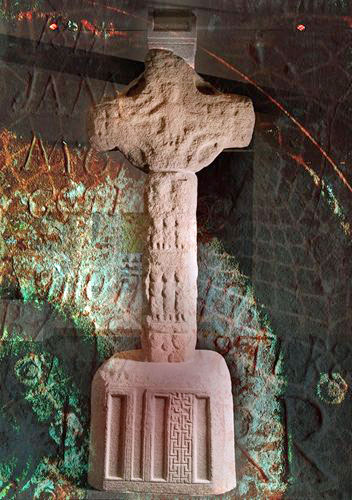 Bangor Historical Society visited Downpatrick for its autumn outing on 17 October 2015. The main purpose was to look at the new gallery which opened recently. It contains the tenth century high cross which formerly stood in front of the Cathedral. We were given an excellent guided tour by a trained archaeologist.
Bangor Historical Society visited Downpatrick for its autumn outing on 17 October 2015. The main purpose was to look at the new gallery which opened recently. It contains the tenth century high cross which formerly stood in front of the Cathedral. We were given an excellent guided tour by a trained archaeologist.
By the late eighteenth century the pieces of the high cross were scattered along English Street in the town. In 1897 Joseph Biggar and the members of the Belfast Naturalists’ Field Club had it reassembled and placed in front of the cathedral. The base was used as a font in the cathedral.
By the early twenty first century it was clear that the cross was suffering badly from weathering. Mike King, museum curator, got the funding which would enable it to be brought into the museum for protection. The East Border Region Tourism Partnership provided the £400,000 necessary to create a new gallery in the former yard to house the cross and tell its story. The floor had to be specially reinforced. A replica of the cross was put in front of the cathedral.
An excavation of the site took place. The base stone was so heavily concreted in that it could not be moved and a new base had to be made. This was carved from a lighter coloured granite so that the difference from the original Mourne granite was clear. The capstone is also modern as the steel rods put in in 1897 had led to water seeping in and causing damage.
High crosses are thought to have marked the boundaries between church and secular land as well as telling stories from the bible at a time when most people were illiterate. Our guide stressed the impact the arrival of Christianity would have had on people who believed in many gods and so the crosses were a form of propaganda for Christianity.
The figures on the cross are rather worn. The central part contains the crucifixion on one side and the last judgement on the other. The scene at the bottom of the shaft is incomplete. The capstone is similar in design to the reliquaries which would have been in some churches.
We were than told about some of the explanatory panels on the walls of the gallery. One showed a reconstruction drawing of the cathedral site about 1000 AD. Various buildings included the church, the abbot’s house, the monk’s cells and the scriptorium. A ditch surrounded the site. An excavation was carried out in the 1980s before the cathedral graveyard was extended and this revealed graves. Most were of adult men, but some skeletons belonged to women and children.
Another reconstruction showed the site after the arrival of the Normans in 1177. John de Courcy brought Benedictine monks who erected a cathedral, cloister, refectory and other buildings. Nearby was the River Quoile which provided a means of transport superior to the wooden trackways of the time. It was also used to bring goods to the settlement as well as the granite for the buildings. De Courcy found three graves on the site which he assumed were those of Saints Patrick, Brigid and Columcille. He had them ceremonially reburied on the site. He also began to construct a motte on the nearby Mound of Down, but it was never finished as he moved to Carrickfergus.
Members then had the opportunity to view the gallery, see other parts of the museum and visit the shop. Most went to the new Cathedral Café from which there is a very good view of the surrounding landscape.
